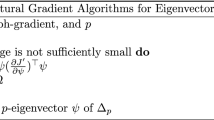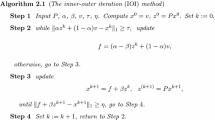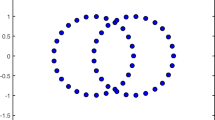Abstract
Motivated by the PageRank model for graph partitioning, we develop an extension of PageRank for partitioning uniform hypergraphs. Starting from adjacency tensors of uniform hypergraphs, we establish the multi-linear pseudo-PageRank (MLPPR) model, which is formulated as a multi-linear system with nonnegative constraints. The coefficient tensor of MLPPR is a kind of Laplacian tensors of uniform hypergraphs, which are almost as sparse as adjacency tensors since no dangling corrections are incorporated. Furthermore, all frontal slices of the coefficient tensor of MLPPR are M-matrices. Theoretically, MLPPR has a solution, which is unique under mild conditions. An error bound of the MLPPR solution is analyzed when the Laplacian tensor is slightly perturbed. Computationally, by exploiting the structural Laplacian tensor, we propose a tensor splitting algorithm, which converges linearly to a solution of MLPPR. Finally, numerical experiments illustrate that MLPPR is effective and efficient for hypergraph partitioning problems.










Similar content being viewed by others
Data Availability
Data Availability Enquiries about data availability should be directed to the authors.
References
Brin, S., Page, L.: The anatomy of a large-scale hypertextual Web search engine. Comput. Netw. ISDN Syst. 30(1), 107–117 (1998). https://doi.org/10.1016/S0169-7552(98)00110-X
Bryan, K., Leise, T.: The \$ 25,000,000,000 eigenvector: the linear algebra behind Google. SIAM Rev. 48(3), 569–581 (2006). https://doi.org/10.1137/050623280
Gleich, D.F.: PageRank beyond the Web. SIAM Rev. 57(3), 321–363 (2015). https://doi.org/10.1137/140976649
Langville, A.N., Meyer, C.D.: Google’s PageRank and Beyond: The Science of Search Engine Rankings. Princeton University Press, Princeton (2006)
Arrigo, F., Higham, D.J., Noferini, V.: Non-backtracking PageRank. J. Sci. Comput. 80, 1419–1437 (2019). https://doi.org/10.1007/s10915-019-00981-8
Benson, A.R., Gleich, D.F., Leskovec, J.: Higher-order organization of complex networks. Science 353(6295), 163–166 (2016). https://doi.org/10.1126/science.aad9029
Benson, A.R., Gleich, D.F., Lim, L.-H.: The spacey random walk: a stochastic process for higher-order data. SIAM Rev. 59(2), 321–345 (2017). https://doi.org/10.1137/16M1074023
Kossinets, G., Watts, D.J.: Empirical analysis of an evolving social network. Science 311(5757), 88–90 (2006). https://doi.org/10.1126/science.1116869
Rosvall, M., Esquivel, A.V., Lancichinetti, A., West, J.D., Lambiotte, R.: Memory in network flows and its effects on spreading dynamics and community detection. Nat. Commun. 5, 4630 (2014). https://doi.org/10.1038/ncomms5630
Ipsen, I.C.F., Selee, T.M.: PageRank computation, with special attention to dangling nodes. SIAM J. Matrix Anal. Appl. 29(4), 1281–1296 (2008). https://doi.org/10.1137/060664331
Francesco, T.: A note on certain ergodicity coefficients. Special Matrices 3(1), 175–185 (2015). https://doi.org/10.1515/spma-2015-0016
Langville, A.N., Meyer, C.D.: A reordering for the pagerank problem. SIAM J. Sci. Comput. 27(6), 2112–2120 (2006). https://doi.org/10.1137/040607551
Chung, F.: Laplacians and the Cheeger inequality for directed graphs. Ann. Comb. 9(1), 1–19 (2005). https://doi.org/10.1007/s00026-005-0237-z
Andersen, R., Chung, F., Lang, K.: Using PageRank to locally partition a graph. Internet Math. 4(1), 35–64 (2007)
Andersen, R., Chung, F., Lang, K.: Local partitioning for directed graphs using PageRank. Internet Math. 5(1–2), 3–22 (2008). https://doi.org/10.1007/978-3-540-77004-6_13
Li, W., Ng, M.K.: On the limiting probability distribution of a transition probability tensor. Linear Multilinear Algebra 62(3), 362–385 (2014). https://doi.org/10.1080/03081087.2013.777436
Gleich, D.F., Lim, L.-H., Yu, Y.: Multilinear PageRank. SIAM J. Matrix Anal. Appl. 36(4), 1507–1541 (2015). https://doi.org/10.1137/140985160
Chang, K.C., Zhang, T.: On the uniqueness and non-uniqueness of the positive Z-eigenvector for transition probability tensors. J. Math. Anal. Appl. 408(2), 525–540 (2013). https://doi.org/10.1016/j.jmaa.2013.04.019
Fasino, D., Tudisco, F.: Ergodicity coefficients for higher-order stochastic processes. SIAM J. Math. Data Sci. 2(3), 740–769 (2020). https://doi.org/10.1137/19M1285214
Li, W., Liu, D., Ng, M.K., Vong, S.-W.: The uniqueness of multilinear PageRank vectors. Numer. Linear Algebra Appl. 24(6), 2107–112 (2017). https://doi.org/10.1002/nla.2107
Li, W., Liu, D., Vong, S.-W., Xiao, M.: Multilinear PageRank: uniqueness, error bound and perturbation analysis. Appl. Numer. Math. 156, 584–607 (2020). https://doi.org/10.1016/j.apnum.2020.05.022
Li, W., Cui, L.-B., Ng, M.K.: The perturbation bound for the Perron vector of a transition probability tensor. Numer. Linear Algebra Appl. 20(6), 985–1000 (2013). https://doi.org/10.1002/nla.1886
Benson, A.R.: Three hypergraph eigenvector centralities. SIAM J. Math. Data Sci. 1(2), 293–312 (2019). https://doi.org/10.1137/18M1203031
Benson, A.R., Gleich, D.F., Leskovec, J.: Tensor spectral clustering for partitioning higher-order network structures. In: Proceedings of the 2015 SIAM International Conference on Data Mining, pp. 118–126 (2015)
Meini, B., Poloni, F.: Perron-based algorithms for the multilinear PageRank. Numer. Linear Algebra Appl. 25(6), e2177 (2018). https://doi.org/10.1002/nla.2177
Huang, J., Wu, G.: Convergence of the fixed-point iteration for multilinear PageRank. Numer. Linear Algebra Appl. 28(5), 2379 (2021). https://doi.org/10.1002/nla.2379
Liu, D., Li, W., Vong, S.-W.: Relaxation methods for solving the tensor equation arising from the higher-order Markov chains. Numer. Linear Algebra Appl. 26(5), 2260 (2019). https://doi.org/10.1002/nla.2260
Cipolla, S., Redivo-Zaglia, M., Tudisco, F.: Extrapolation methods for fixed-point multilinear PageRank computations. Numer. Linear Algebra Appl. 27(2), 2280 (2020). https://doi.org/10.1002/nla.2280
Yuan, A., Calder, J., Osting, B.: A continuum limit for the PageRank algorithm. Eur. J. Appl. Math. 33(3), 472–504 (2022). https://doi.org/10.1017/S0956792521000097
Bulò, S.R., Pelillo, M.: A game-theoretic approach to hypergraph clustering. IEEE Trans. Pattern Anal. Mach. Intell. 35(6), 1312–1327 (2013). https://doi.org/10.1109/TPAMI.2012.226
Cooper, J., Dutle, A.: Spectra of uniform hypergraphs. Linear Algebra Appl. 436(9), 3268–3292 (2012). https://doi.org/10.1016/j.laa.2011.11.018
Qi, L., Luo, Z.: Tensor Analysis: Spectral Theory and Special Tensors. SIAM, Philadelphia (2017)
Gao, G., Chang, A., Hou, Y.: Spectral radius on linear \(r\)-graphs without expanded \(k_{r+1}\). SIAM J. Discret. Math. 36(2), 1000–1011 (2022). https://doi.org/10.1137/21M1404740
Huang, J., Wu, G.: Truncated and sparse power methods with partially updating for large and sparse higher-order PageRank problems. J. Sci. Comput. 95, 34 (2023). https://doi.org/10.1007/s10915-023-02146-0
Li, W., Ng, M.K.: Some bounds for the spectral radius of nonnegative tensors. Numer. Math. 130, 315–335 (2015). https://doi.org/10.1007/s00211-014-0666-5
Liu, C.-S., Guo, C.-H., Lin, W.-W.: Newton-Noda iteration for finding the Perron pair of a weakly irreducible nonnegative tensor. Numer. Math. 137, 63–90 (2017). https://doi.org/10.1007/s00211-017-0869-7
Chen, Y., Qi, L., Zhang, X.: The Fiedler vector of a Laplacian tensor for hypergraph partitioning. SIAM J. Sci. Comput. 39(6), 2508–2537 (2017). https://doi.org/10.1137/16M1094828
Eberly, D.: Least squares fitting of data by linear or quadratic structures, Redmond WA 98052 (Created: July 15, 1999; Last Modified: September 7, 2021)
Leskovec, J., Krevl, A.: SNAP datasets: stanford large network dataset collection (2014)
Acknowledgements
The authors are grateful to the associate editor and anonymous referees for helping us improve the manuscript.
Funding
This work was funded by the National Natural Science Foundation of China grants 12171168, 12071159, 12326302, 62073087, and U1811464.
Author information
Authors and Affiliations
Corresponding author
Ethics declarations
Conflict of interest
The authors declare that they have no conflict of interest.
Additional information
Publisher's Note
Springer Nature remains neutral with regard to jurisdictional claims in published maps and institutional affiliations.
Rights and permissions
Springer Nature or its licensor (e.g. a society or other partner) holds exclusive rights to this article under a publishing agreement with the author(s) or other rightsholder(s); author self-archiving of the accepted manuscript version of this article is solely governed by the terms of such publishing agreement and applicable law.
About this article
Cite this article
Chen, Y., Li, W. & Chang, J. Multi-Linear Pseudo-PageRank for Hypergraph Partitioning. J Sci Comput 99, 7 (2024). https://doi.org/10.1007/s10915-024-02460-1
Received:
Revised:
Accepted:
Published:
DOI: https://doi.org/10.1007/s10915-024-02460-1
Keywords
- PageRank
- Multi-linear system
- Existence
- Uniqueness
- Perturbation analysis
- Splitting algorithm
- Convergence
- Hypergraph
- Laplacian tensor
- Hypergraph partitioning
- Network analysis





